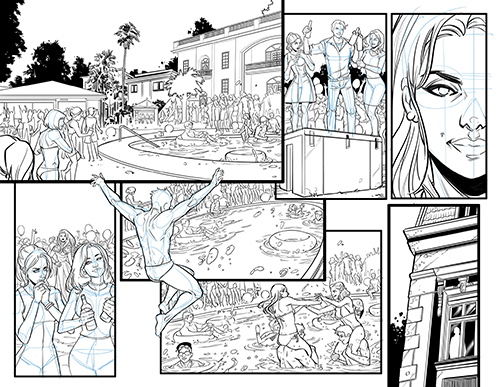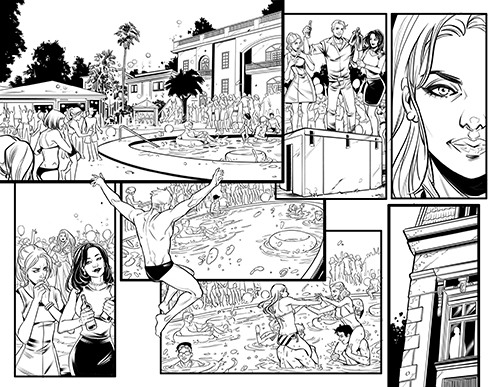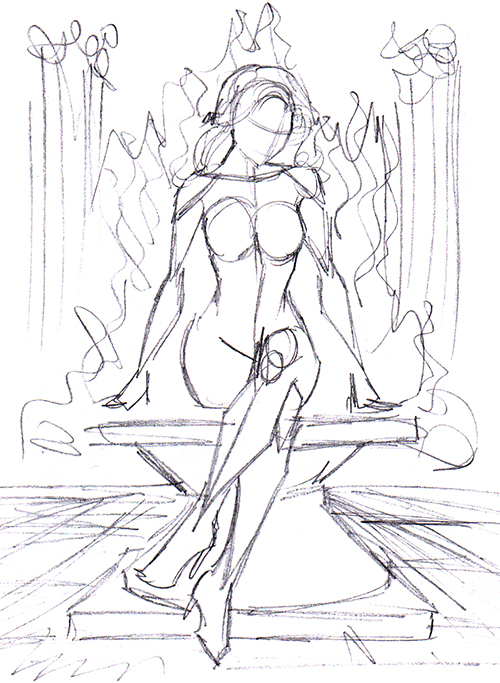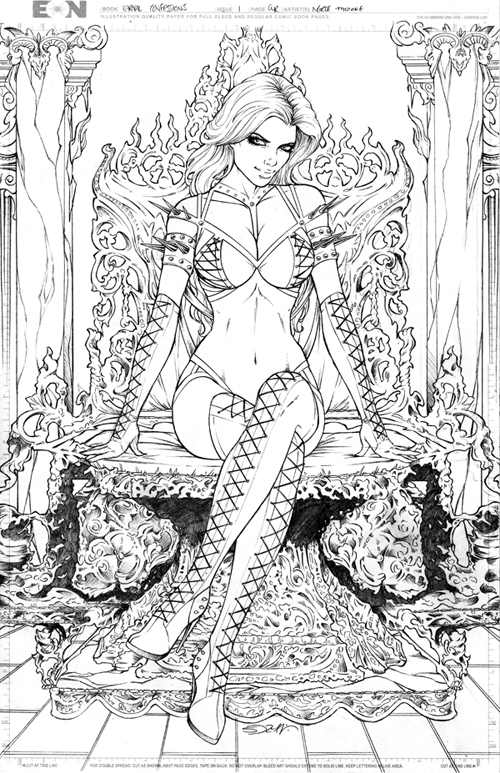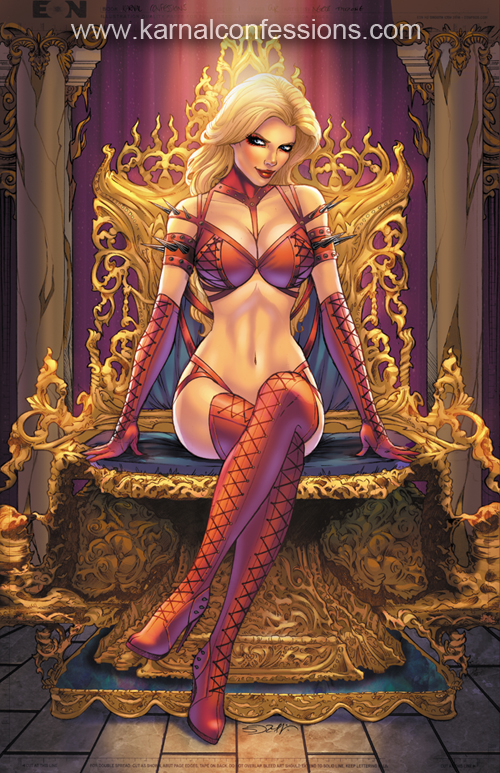Women In Comics Month: The Art of Laura Braga & Sorah Suhng
Mar 28, 2019
by Troy-Jeffrey Allen
We close out PREVIEWSworld's Women in Comics Month with a pair of creative forces whose works have graced the covers of several premiere publishers. First up, DC Bombshells and Blossoms 666's Laura Braga takes us inside the process. Then, Ninja-K and Iron Man's Sorah Suhng closes out Women in Comics Month by showing us how the magic is made.
And be sure to read or previous Women in Comics Month interviews with Ashley Woods, Yishan Li, Christina Steenz Stewart, and Roberta Ingranata.
Laura Braga (Instagram, Twitter, Facebook)
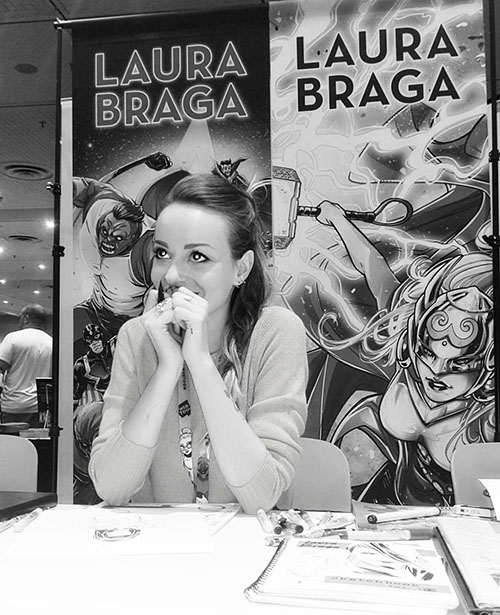
Laura on how she got into comics as a reader:
Since I can remember, I've always read and loved comics. When I was a child and I still couldn’t read yet, [my] first comic was "Mickey Mouse." My grandfather bought it for me every week. It's a very sweet memory for me.
Laura on how she got into comics as a pro:
I started working in the world of comics in the 2002. I worked for Italian publishers, at first as [an inker and as a] background assistant. Later, I worked as a comics artist and illustrator for kids books. My style was very different from now. It was much more cartoon-like because I studied at the Disney Academy.
Only later [did] my style change to become more realistic.
I had been dreaming to work on American superheroes for several years. [Finally] in 2014, I had the chance to start working on Witchblade, thanks to Ron Marz and Top Cow.
Laura on what tools/medium she typically uses for her art:
I worked on these pages for Blossoms 666 (below) in digital. Usually, I work in digital for most of the interior pages, and on paper for covers. I used Ipad Pro with the Procreate App. I look for specific types of brushes like "rough" brushes, irregular, with a scratched line that reproduces the effect of a dry brush.
On Photoshop I created my brushes, while with procreate I found the brushes that "suit me.” I think the brush is very important and can make the difference in the stroke and line, but it's also true that there isn’t a brush perfect for everyone. It depends on your hand and what you want to achieve.
Usually, I start working on a very fast layout, just to understand the sizes, characters positions, and backgrounds. Later I work on a more detailed layout, but still not so defined to be considered a full pencil. From this detailed layout, I work directly on the inks when I work digitally; otherwise, if I work on paper, I make an additional step of pencils. I ink all the characters first. Then I work on backgrounds and at the end on black shadows, light, and effects.
Blossoms 666 #1 (NOV181518) is available now at your local comic shop.
Sorah Suhng (Instagram, Facebook, Twitter, Website)
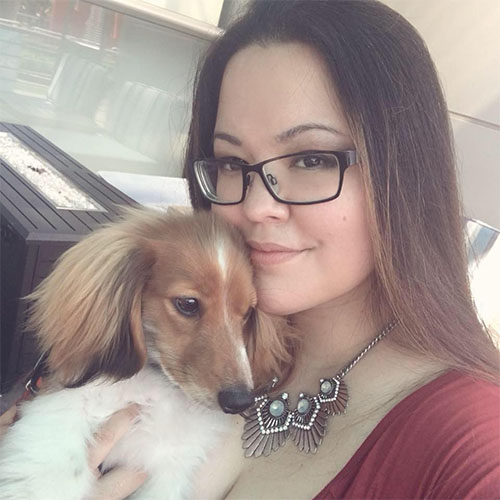
Sorah on how she got into comics as a reader:
I got interested in comics after watching, and loving, the 90s X-Men cartoon on Fox Kids. I had spent most of my childhood overseas in Asia, so my exposure to American Pop Culture was relatively limited as my family lived off-base (and thus we had no access to American cable). From there I visited the bookstore where they carried comics on base, and naturally, began to read X-Men first. I dabbled in reading some Batman, especially if there was anything to do with Catwoman, but my first love was Marvel Comics and the science fiction aspect of their shared universe.
Sorah on how she got into comics as a pro:
When I was in college, instead of partying and running amuck, I was actually spending my time between classes playing a now-defunct video-game that was generically based on superheroes called "City of Heroes/City of Villains." I had always drawn, mostly manga style, my whole life, and I just randomly started to draw my characters from that game - at first in manga, then I attempted the western style of comics. As I made friends in the game, I eventually showed them, and they asked me to draw their characters. Then random people who I didn't know saw my art and asked me to draw their characters and offered me money. I had always told myself I never wanted to turn my hobby into a career, but I found myself enjoying the work. That game had an accompanying comic book that was being published at the time by Top Cow. My art was often featured in the back of the book in the Fan Art section. This eventually led to their website where I discovered such amazing artists as Marc Silvestri and Michael Turner. I remember looking at their work and thinking, "I want to draw like them." I had very little understanding of the industry at the time, and had not even a notion on how to become a professional comic book artist - just this vague idea that I wanted to draw comics and I enjoyed telling stories.
Fast forward a year from that far-fetched dream and I was working at a Starbucks between semesters. Coincidentally, one of the regulars at the shop turned out to be none other than Bob Layton, who was local. It took me three solid months of building up the courage to even talk to him about artwork, and actually it was my manager at the time who ended up nudging HIM to talk to me because I was so painfully shy. He humored me, and set up a portfolio review on my day off. He ended up hiring me as an art assistant and I got my first background inking gig working on Iron Man for Marvel through him!
I eventually left the inking field to pursue penciling and writing, which is what I'm doing today, where I'm still cultivating my own look. I no longer want to draw like Silvestri or Turner, however. I still love their work and they're my go-to favorites, I'm just focusing on developing my own look.
Sorah on what tools/medium she typically uses for her art:
I always start with a thumbnail, on cheap printer paper! I use #H lead in a Staedtler lead holder, Tombow zero manga eraser, Factis BM2 eraser, and just a generic broader eraser I get on Amazon in bulk. Once I land on a thumbnail I like or can work with, I scan that into my computer and I manipulate it in Photoshop until I'm happy, as well as size it to the page, making sure I have enough room for title/logo/copy and toss in any references needed, in this case, I referenced, with obvious adjustments, Buddha's throne for the throne she is sitting on. Then I print it out full-size 11x17, and I use a lightbox from there - pulling only the necessary lines I need from the roughs, which keeps my page pretty clean. I tend to pencil pretty lightly.
The colors are actually from my amazing talented colorist who goes by Kate Colors. She's phenomenal and really bought my lines to life on this. She's all digital, so she uses a tablet and Photoshop and years and years of practice to accomplish something like this!
This piece of art is a cover for Kickstarter project called Karnal Confessions, launching March 27th!
You can support Karnal Confessions on Kickstarter now.
If you're looking for more deep dives into contemporary comic art then check out our monthly "Got It Covered" series. There you'll discover some of the industry's top talents and witness their artistic process.
****
Troy-Jeffrey Allen is the producer and co-host of PREVIEWSworld Weekly. His comics work includes BAMN, Fight of the Century, the Harvey Awards-nominated District Comics, and the Ringo Awards-nominated Magic Bullet.


